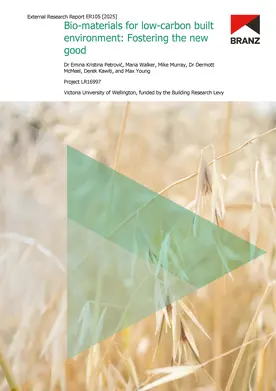
ER105 Biomaterials for low-carbon built environment: Fostering the new good (April 2025)
Product Description
To realise Aotearoa New Zealand’s zero-carbon aspirations, the industry needs to rethink its assumptions about what materials should be used in the built environment. This can be achieved by engaging with promising novel and more established biomaterials. These materials are derived from or produced by biological organisms like plants, animals, bacteria, fungi and other lifeforms. These are often low carbon, and most biomaterials such as hempcrete or mycelium-based biocomposites actually reduce carbon through absorption during their growth phase.
This project sought to determine the barriers and drivers to accelerate the use of these carbon-reducing biomaterials across the building system. It aimed to identify points where intervention could help stimulate uptake and inform key regulators, innovators and early adopters.
It also aimed to catalogue scientific understanding of the key performance characteristics of different biomaterials and will examine how specific biomaterials engage with mātauranga Māori (Māori knowledge).
Led by Te Herenga Waka Te Kura Waihanga | Victoria University of Wellington School of Architecture, this project brought together researchers from Warren and Mahoney Architects and Te Wānanga Aronui o Tāmaki Makaurau | Auckland University of Technology.
Research and interviews informed the development of intervention-based experimental studies, which were tested with stakeholders and other participants. Based on the results, the team prepared recommendations of possible interventions to help the system transition to using more biomaterials.
Product Information
| Publication date | July 2025 |
|---|---|
| Author | Dr E. K. Petrović, M. Walker, M. Murray, Dr D. McMeel, D. Kawiti, and M. Young |